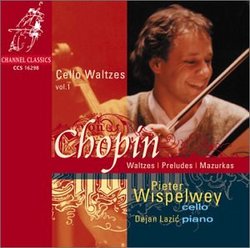| All Artists: Frederic Chopin, Dejan Lazic Title: Chopin: Cello Waltzes, Vol. 1 Members Wishing: 0 Total Copies: 0 Label: Channel Classics Nl Release Date: 1/9/2001 Album Type: Import Genres: Dance & Electronic, Classical Styles: Chamber Music, Historical Periods, Classical (c.1770-1830), Instruments, Strings Number of Discs: 1 SwapaCD Credits: 1 UPC: 723385162988 |
Search - Frederic Chopin, Dejan Lazic :: Chopin: Cello Waltzes, Vol. 1
 | Frederic Chopin, Dejan Lazic Chopin: Cello Waltzes, Vol. 1 Genres: Dance & Electronic, Classical |
Larger Image |
CD DetailsSimilar CDs
|
CD ReviewsCellistic Chopin on Channel Brian Forst | Reston, VA United States | 01/19/2001 (5 out of 5 stars) "Frederic Chopin is automatically associated with piano, but there's a strong cello connection too. Most of Chopin's small output of chamber ensembles are for cello and piano. Much of his keyboard music is written in the baritone legato lines that suggest cello. Now cellist Pieter Wispelwey has joined the Russian romantics Glazanov, Davidov, and Piatigorsky (the latter two, also celebrated cellists) in transcribing Chopin keyboard classics to miniatures for cello and piano.Wispelwey has become many a cellist's cellist. He combines technical skill with musicianship in a manner that takes one's breath away. He has dazzled audiences with extraordinary "authentic" renditions of Bach and Vivaldi, and given electrifying modern-style performances of edgy works by Kodaly, Ligeti, Crumb and Carter. In this CD, tantalizingly titled "Volume 1" of Chopin's Cello Waltzes, Wispelwey plays portions of Chopin's cello repertoire, plus transcriptions by the three Russians noted above, and added ten more transcriptions in collaboration with pianist-composer Dejan Lazic, from the place formerly known as Yugoslavia.Wispelwey and Lazic conceive and play these pieces emphasizing Chopin's playfulness in the waltzes generally and in the Grand Valses Brilliante (Op. 18 and 34) in particular, and Chopin's deep passion and grace in the Polonaise Brilliante and sorrowful Prelude #4 in e minor. Wispelwey finds new colors in the Polonaise Brilliante using exquisite long bows and inspired rubato. And Channel Classics lends the sort of closely miked sound technology to this project that its patrons have come to appreciate.The close miking puts the listener right there, a companion to the performers. Wispelwey's fingerboard pops are a bit of a distraction at times, especially in tracks #9 (Mazurka in a minor) and 15 (Prelude #3 in g major, a rare moment when the piano gets the melody, backed up by an intricate cello accompaniment), but the intimacy more than compensates for these minor disturbances.Another difficulty is the decision to make this a musical book of short stories; thus we get just a single movement of Chopin's only cello sonata. Perhaps the other three movements will show up on Volume 2. Either way, Wispelwey and Lazic don't give us this extraordinary sonata as Chopin offered it to us.These are just quibbles, however. If you like great romantic music, or just Chopin, or just great cello music, or just Pieter Wispelwey, this is a not-to-be-missed CD."
|


